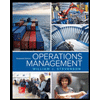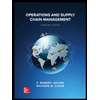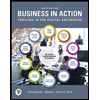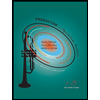
Practical Management Science
6th Edition
ISBN: 9781337406659
Author: WINSTON, Wayne L.
Publisher: Cengage,
expand_more
expand_more
format_list_bulleted
Concept explainers
Topic Video
Question
A building materials stockist obtains its cement from a single supplier. Demand
for cement is reasonably constant throughout the year. Last year the company sold 2 000
tonnes of cement. It estimates the costs of placing an order at around 25 MU each time
an order is placed and charges inventory holding at 20% of purchase cost. The company
purchases cement at 60 MU per tonne.
a) How much cement should the company order at a time?
b) Instead of ordering EOQ, why not a order convenient 100 tonnes?
Please mention formulas and do it in detail so I can understand.
Expert Solution
This question has been solved!
Explore an expertly crafted, step-by-step solution for a thorough understanding of key concepts.
This is a popular solution
Trending nowThis is a popular solution!
Step by stepSolved in 2 steps

Knowledge Booster
Learn more about
Need a deep-dive on the concept behind this application? Look no further. Learn more about this topic, operations-management and related others by exploring similar questions and additional content below.Similar questions
- Jean-Ma rie Bourjolly's restau rant has the followinginventory items that it orders on a weekly basis: a) Which is the most expensive item, using annual dollar volume?b) Which are C items?c) What is the annual dollar volume for all 20 items?arrow_forwardAn Electronics parts manufacturer purchases circuit board for manufacturing electronic circuit board at the rate of OMR 20 per piece from a vendor. The requirements of these parts are 1000 per quarterly and the cost per placement of an order is OMR 40 and inventory carrying charges 10 percent yearly. Calculate the following The EOQ No. of orders in a year, and Time between two successive orders Average yearly cost of Inventory Total inventory cost Total Costarrow_forwardSumco's annual demand is expected to increase from 1,000 units to 1,500 units, the ordering cost is reduced to $8 per order and the average carrying cost per unit per year is increased to $0.80. Under these new conditions: A) Calculate the new EOQ. B) Calculate the Annual Ordering Cost, the Annual Holding Cost and the Total Annual Cost. C) Plot a graph showing Ordering Cost, Holding Cost and Total Cost as a function of Q for this problem Predictions: On acerarrow_forward
- The electrolyte drink for our beloved NMSU soccer team average normally distributed demand of 5 units and a standard deviation of 1 unit. Lead time for replenishment is fixed at four days. (a) What is the reorder point if there is no safety stock? (b) What is the reorder point if the service level is 80 percent? (c) How much more safety stock is required if the service level is raised from 80 percent to 90 percent?arrow_forwardPlease show work so I can understand it. Given this information: •Expected demand during lead time = 800 units • Standard deviation of lead time demand = 40 units Assuming that lead time demand is distributed normally. The risk of stockout is 5 percent during lead time (a) What amount of safety stock is appropriate? (b) Calculate ROParrow_forwardAll Seasons Flower Shop uses 870 clay pots a month. The pots are purchased at $ 6 each. Annual holding cost per pot is estimated to be 35% of purchase cost. Ordering cost is $ 40 per order. The shop operates 12 months in a year. What would be the difference in total cost if an order quantity of 1000 is used instead of the EOQ. Note: calculate the difference as “total cost with Q = 1000 – total cost with EOQ”.arrow_forward
- A store sells university coffee mugs. Daily demand is 25 mugs with a standard deviation of 4 mugs per day. Each mug costs $7.85. Ordering costs are $11. The carrying costs are $2 per year. The store is open 250 days per year. Lead time is 6 days with a standard deviation of 1.6 days. Desired service level is 98%. Calculate the EOQ (round your answer to the nearest whole number) 2. CAREFUL! YOUR NUMBERS HAVE CHANGED A store sells university logo hats. Daily demand is 22 hats with a standard deviation of 4 hats per day. Each hat costs $7.85. Ordering costs are $12. The carrying costs are $1 per year. The store is open 250 days per year. Lead time is 4 days with a standard deviation of 1.6 days. Desired service level is 98%. Calculate the ROP with safety stock.arrow_forwardA manufacturer buys cardboard boxes from a supplier. The annual demand is 40,000 boxes and is uniformly distributed. The boxes cost $5 each. The estimated order cost is $10, and the carrying cost rate is 20% per year. What is the EOQ and what is the annual order and carrying cost? How many times a year are orders placed, and what is the average time, in weeks, between orders? Using the answer from (b), if you round the average time between orders to the nearest week, what should the order quantity be? Would you recommend using this order quantity and time interval? Suppose that the actual demand turns out to be 80,000 boxes instead of 40,000 boxes.If you had used the EOQ from the (a), what would be the annual order and carrying cost be?arrow_forwardJoe Henry's machine shop uses 2,530 brackets during the course of a year. These brackets are purchased from a supplier 90 miles away. The following information is known about the brackets: Annual demand 2,530 Holding cost per bracket per year $1.65 Order cost per order $18.25 Lead time 2 days Working days per year 250 Part 2 a) What is the EOQ? enter your response here units (round your response to two decimal places). Part 3 b) What is the average inventory if the EOQ is used? enter your response here units (round your response to two decimal places). What would be the annual inventory holding cost? $enter your response here (round your response to two decimal places). Part 4 c) Given the EOQ, how many orders will be made annually? enter your response here orders (round your response to two decimal places). What would be the annual order cost? $enter your response here (round…arrow_forward
- Discuss what is meant by ABC analysis of inventory.Name several measures that can determine ABCstatusarrow_forwardA museum of natural history is having problems managing their inventories. Low inventory turnover is squeezing profit margins and causing cash-flow problems. A Class A item, a birdfeeder is also a top-selling item. See information for this item in the table below. Management has been ordering in lots of 390 units. 1) What is the annual cost of the current policy (hint: find the current total cost with the current order size, Q)? 2) What is the Economic Order Quantity or the optimum order quantity (EOQ) for the birdfeeders? 3) What is the total annual cost of ordering at the EOQ? How much could be saved if the museum ordered at the EOQ opposed to their current order size of 390 units? 4) When should the museum place an order, at how many units (i.e.: what is their reorder point or lead time demand)? Sales per week (demand) Purchase cost Order cost Annual holding cost Birdfeeder: Operating weeks per year Lead time for orders (weeks) Order size EOQ (calculated) 18 $ $ 60.00 45.00 25% of…arrow_forwardCan someone please help me with the folowing problems on excel with the formulas. Thank youarrow_forward
arrow_back_ios
SEE MORE QUESTIONS
arrow_forward_ios
Recommended textbooks for you
 Practical Management ScienceOperations ManagementISBN:9781337406659Author:WINSTON, Wayne L.Publisher:Cengage,
Practical Management ScienceOperations ManagementISBN:9781337406659Author:WINSTON, Wayne L.Publisher:Cengage, Operations ManagementOperations ManagementISBN:9781259667473Author:William J StevensonPublisher:McGraw-Hill Education
Operations ManagementOperations ManagementISBN:9781259667473Author:William J StevensonPublisher:McGraw-Hill Education Operations and Supply Chain Management (Mcgraw-hi...Operations ManagementISBN:9781259666100Author:F. Robert Jacobs, Richard B ChasePublisher:McGraw-Hill Education
Operations and Supply Chain Management (Mcgraw-hi...Operations ManagementISBN:9781259666100Author:F. Robert Jacobs, Richard B ChasePublisher:McGraw-Hill Education
 Purchasing and Supply Chain ManagementOperations ManagementISBN:9781285869681Author:Robert M. Monczka, Robert B. Handfield, Larry C. Giunipero, James L. PattersonPublisher:Cengage Learning
Purchasing and Supply Chain ManagementOperations ManagementISBN:9781285869681Author:Robert M. Monczka, Robert B. Handfield, Larry C. Giunipero, James L. PattersonPublisher:Cengage Learning Production and Operations Analysis, Seventh Editi...Operations ManagementISBN:9781478623069Author:Steven Nahmias, Tava Lennon OlsenPublisher:Waveland Press, Inc.
Production and Operations Analysis, Seventh Editi...Operations ManagementISBN:9781478623069Author:Steven Nahmias, Tava Lennon OlsenPublisher:Waveland Press, Inc.

Practical Management Science
Operations Management
ISBN:9781337406659
Author:WINSTON, Wayne L.
Publisher:Cengage,

Operations Management
Operations Management
ISBN:9781259667473
Author:William J Stevenson
Publisher:McGraw-Hill Education

Operations and Supply Chain Management (Mcgraw-hi...
Operations Management
ISBN:9781259666100
Author:F. Robert Jacobs, Richard B Chase
Publisher:McGraw-Hill Education


Purchasing and Supply Chain Management
Operations Management
ISBN:9781285869681
Author:Robert M. Monczka, Robert B. Handfield, Larry C. Giunipero, James L. Patterson
Publisher:Cengage Learning

Production and Operations Analysis, Seventh Editi...
Operations Management
ISBN:9781478623069
Author:Steven Nahmias, Tava Lennon Olsen
Publisher:Waveland Press, Inc.